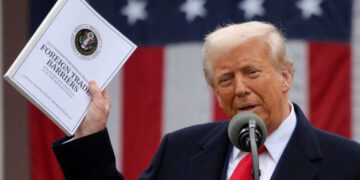By John F Di Leo -
Last week, our family’s 20 year old electric hand mixer died. We can’t complain; it lasted a long time, and got a lot of use. But it did mean that it was time to go shopping.
Now, we do a lot of research on many of the products we buy; a cheap hand mixer, however, did not feel like it merited that kind of research. I just headed to Walmart, expecting to grab one and go.
I was surprised by two things in this shopping trip: both a larger selection than I expected, and a narrower choice of countries of origin than I would have thought possible a few years ago.
I should stress at the outset that this is not a slam against Walmart. Walmart only makes one of the products listed for sale, and while there are many reasons to be angry at Walmart, the subject of today’s column is not among them. I am just using them as a typical example of a reseller, selling a variety of products available on the market today.
The Choices
On the shelf in the kitchen section at our local Walmart, there were six options for handmixers last week. When I was a boy, I used a manual one… And it was fine. But all they sell now are electronic ones, which is OK, but means the products are more complicated, raising the barrier to entry for producers.
I had six models to choose from, offered by four brands. The cheapest was Walmart’s own brand, made for them in China. There were two models from Hamilton Beach, a cheaper one and a better one, both of which were made in China. There were two models offered by Black & Decker, a mid range one and a more expensive one, both of which were also made in China. The most expensive one was made by KitchenAid, here in the United States. The price range, from cheapest to most expensive, at this Chicagoland Walmart at this moment in time, started at $10 and maxed out at $32.
A proper kitchen requires a number of different appliances. You certainly need a blender, a handmixer, a food processor, and maybe a fancy cast-iron stand mixer, if you do more ambitious things in your kitchen. The first couple of those tend to be cheaper, the last couple can be quite expensive.
To me, a little hand mixer feels like it ought to be relatively simple and cheap. That is a personal judgment, and it could be wrong. There are certainly some offerings in that space that involve additional attachments, different blade options to differentiate themselves from their competitors etc., but, all in all, a handmixer is a handmixer. There is a limit to how complicated it should get.
Has Walmart done their job, in offering its consumers a good range? I would say yes. Four brands, six models. I can’t complain about that.
But if we look at this from a macro level, is it really as good a range of offerings as it appears?
The Manufacturers
One of the things we have learned about the world marketplace in recent years is that there is a great deal more toll manufacturing going on than most of us grew up expecting.
As children, we learned to recognize brands, and differentiated them from each other in our minds. Tropicana, Florida’s Natural, and Minute Maid were the competing brands of orange juice. Trek, Schwinn and Huffy were competing brands of bicycles. And speaking of bicycles… Bicycle, Hoyle and Piatnik were competing brands of playing cards.
Growing up in America, especially in the television and radio age, we were bombarded by commercials, reinforcing the idea that each brand was manufactured by a distinct company, all separate competitors, making things differently, with perhaps different specialties, distinguished from each other in recognizable ways.
We grew up as fans of the Chrysler line, or the GM line, or the Ford line. We thought of them as truly being distinct entities.
Today, however, many brands are just brands – logos – a marketing tool, nothing more. Private labeling has become the technique of the era, as a way to offer more variety than you can manufacture yourself, while getting the most out of your advertising dollars.
Today, therefore, it is difficult to know whether a product was really manufactured by the company and its label, or just made for them, by some toll manufacturer overseas. Sometimes there are joint development deals, such as Chrysler and Mitsubishi, collaborating on a design, and making one version with a Chrysler emblem and another version with a Mitsubishi emblem. But more often, the American brand just sends out a bid to existing manufacturers overseas, selects one, and sticks their label on that vendor’s product.
This doesn’t have to be a bad thing. These products may be well-made, may even be wonderful, but I do think that we forget, sometimes, what a difference there Is between developing and manufacturing a product yourself and merely reselling a product made by someone else, on which you just glued your label and shipped out to fill an order.
To return to today’s example, we may ask ourselves how much those brand logos mean on the six products I saw on that shelf last week?
As a consumer, I can safely assume that it is KitchenAid itself that makes this mixer in its own plant in South Carolina. I am equally certain that Walmart does not make the mixer marketed under its name; they found a toll manufacturer in China, and ordered the model from them; simple as that. Walmart is a retail chain, not a manufacturing company.
What about the other two brands I saw? Both Hamilton Beach and Black & Decker are well known for manufacturing appliances, and they certainly both own many of their own plants. But do they own their own plants in China? Or do they buy these items from other people’s plants in China? I don’t know. Perhaps I could check, if I went home and did some hunting on the Internet. Maybe they do own their own plants in China; many companies do… But many do not. It is sometimes hard to tell. And the consumer wants to make his decision at the store, without having to do a lot of research at home.
So we have a challenge, in today’s economy, don’t we? Even when we see a recognizable brand, we don’t really know as much about it as we once did.
To an extent, that represents a bit of a moral decline, in itself: in the old days, a brand was much more than just a marketing tool or a distribution technique.
The Myth of the Low Cost Country
As manufacturing strategies such as lean, six sigma, and organized global sourcing programs have become more and more sophisticated, in the business schools of the west, an interesting idea developed: the idea that a company serves its owners and stockholders best by sourcing its materials and products in the cheapest location they can find.
This has led European and American companies to close down their factories in Europe and America, opening new factories in the third world, or otherwise outsourcing the products to the third world, and keeping only their offices in their original home countries. They think that, by doing so, they “maximize shareholder value,” creating the greatest possible profit delta between the purchase cost and the sale price.
This certainly makes sense on the surface.
What such companies have learned, however, after decades of trial and error, and years of unexpected cost overruns, is that the piece price of a product does not truly represent the total cost of that product.
In actuality, when you buy either materials or finished products from far away, that transportation delta has a cost. Not just the obvious difference between a nearby truck move and an overseas ocean container move. Those differences are often minor.
The key differences, which are rarely considered, and almost never considered in full, are in the people management aspects and the expediting costs when things go wrong.
If an Illinois company buys its components from South Dakota, those parts are here in two or three days. If a new batch needs to be run to replace them, because of a manufacturing error, those replacements are also here in two or three days, with transportation at the same cost.
By contrast, if that Illinois company buys its components from Asia, those parts will take 5 to 10 weeks to get here by sea, and the only way to shorten that transit time is to spend 5 to10 times as much on air freight. If a new batch needs to be run to replace them, because of that same manufacturing error, then those replacements will also take 5 to 10 weeks to get here by sea, or, again, 5 to 10 times as much must be spent to airfreight those urgent replacements.
The business travel involved in this difference is just as crippling. The occasional business trip or phone call between a US manufacturer and a US vendor is easy, convenient, and cheap. Flying engineers, production managers, and other executives to and from toll manufacturers and vendors in Asia both costs the earth to the company, and destroys the family life of the employees called on too often to do it.
Oh yes, the cost of a purchased product or part is more than the price of the piece itself.
Unfortunately, by the time most companies start to realize this (despite years of closing their ears two warnings from their internal staffers), it’s almost too late to fix the problem.
Today, we see more and more companies held hostage by a China-centered supply base, with no idea of how they ever let it get so bad, or of how to correct the error.
Donald Trump and the Flash of Recognition
It would be an exaggeration to say that President Trump was the only person on the national stage to recognize the danger of our dependence on Asia. But he was undoubtedly the most vocal, and most clear, to make the point.
He has been sounding this alarm for decades, so when he finally took office as President, he did the best he could to help drive the return to local sourcing, and to local manufacturing, as part of his America First program.
Four years, unfortunately, was not enough. The Trump administration successfully kick-started a transformation in American sourcing, launching thousands of businesses on the path to re-sourcing and in-sourcing, in an effort to break their dependence on Asia, and on China and particular. The tax and regulatory reforms of the Trump administration, concurrently, spurred thousands of American businesses to start up, or to restart, sparking a new manufacturing renaissance, right here, that had not been seen in decades.
The Biden-Harris administration now hopes that the western economy will forget that the last four years ever existed.
The Biden-Harris administration is counting on the success of its massive intended corporate tax rate increases, along with equally massive planned regulatory revivals, to squelch the green shoots of recent years, and to return to their long mastered path of utterly destroying western manufacturing.
The powers that be, not just the Biden-Harris administration and the DNC, but the globalists who give them their marching orders, will not be satisfied until they see a clear return to the standard practice of smashing Western manufacturing again. They want us dependent on the third world for all our worldly goods… and in particular, on their favorite source, mainland China.
Hand mixers and the odds
Let’s return for a moment to my shopping excursion.
There are 200 countries on this planet earth, at least half of which are capable of modern manufacturing. Why is it, that out of six models available for sale, one was made in the USA, and the other five were made in China?
This may be a random sample, not scientific in the least… But I can assure you that if you look at most other stores in America today, and look at any similar mix of appliances, you will find a similar mix of countries of origin.
Why didn’t I see one American product, and a mix of other origins, including India, China, Korea, Germany and Mexico?
Obviously, I would have been happier to see more American models, though that wouldn’t be as impressive as it may appear, since so many of the internal parts would be known to be imported as well. But I truly would have been happier to see a few more countries represented in this mix.
There is a reason why so many manufactured products come from China. That same reason is also the reason why the Trump administration aimed so much of its energy at this issue. And it is therefore the reason why the Biden-Harris administration is fighting so desperately to undo the accomplishments that the Trump administration made in this direction.
China didn’t gain all this marketshare simply by innovating and producing the best, most honestly competitive products in the world.
Not in the least.
China gained all this market share through a public-private program of tweaking tax policy, subsidizing industries in complex hidden dumping programs, playing with currency exchange rates, meddling in the loan market, violating the valuation rules of the WTO, systemic widespread theft of intellectual property, and more.
The Trump administration did everything it could, both to increase awareness of the challenges and to combat them.
While the Trump administration could not finish the job in these four years, we the American people can carry-on, now that the fight has been joined.
It isn’t all up to the politicians, after all. We choose what we buy, both as businesses and as individual consumers.
Companies that have begun re-sourcing and in-sourcing programs are continuing them. Companies are finally realizing the true cost of dependence upon sources across the oceans.
And the rest of the world has begun to realize that this dependence on China didn’t just hurt the USA, it hurt all of them too.
We cannot – must not – put this genie back in the bottle.
Mexico, Germany, Brazil, France… are also asking themselves, why have they given up so much of their manufacturing to China?
Honduras, Guatemala, Costa Rica, Chile… Why aren’t they sharing in the manufacturing boom that China has heretofore kept to itself?
Yes, many of these countries have done it to themselves, as the USA has, through such socialist policies as high tax rates and over-regulation. But not completely. And not all.
Much of China’s growth has been completely unwarranted, completely unfair, almost a thoughtless me-too process, in which European and American companies, ordered to source from low-cost countries, just quoted China because they thought it was the accepted thing to do. Not for any good reason; Just because they had heard that China was the place to be, and they had no interest in bucking such a trend.
Now that the world has been awakened, now that inertia has been overcome, there is no reason for the process to stop.
We ARE gradually going to declare ourselves independent of China. Not even because everyone necessarily wants to…
But because we must.
Copyright 2021 John F Di Leo
John F Di Leo is a Chicagoland-based trade compliance trainer and transportation manager. His columns have been found in Illinois review for 12 years. A collection of John’s many Illinois Review columns on vote fraud in America, The Tales of Little Pavel, is available on Amazon in either a book or paperback!
Don’t miss an article! Use the free tool in the margin to sign up for Illinois reviews free email notification service, so you always know when Illinois review publishes new contact!








